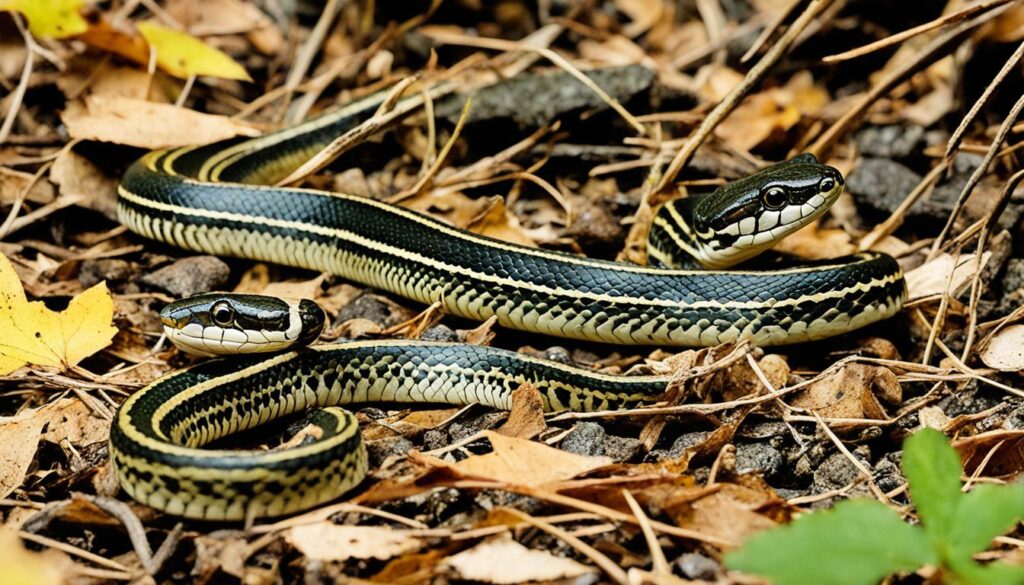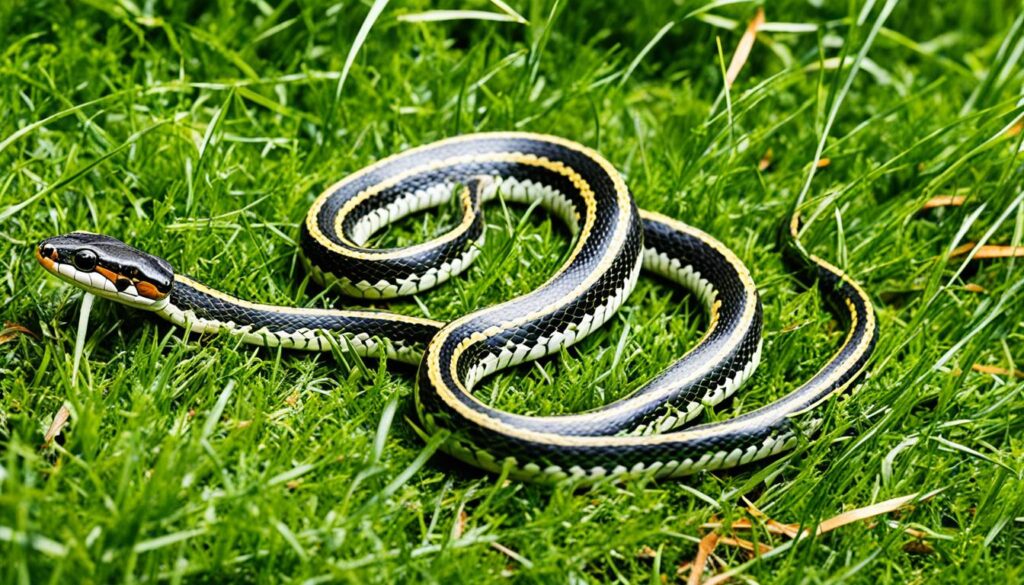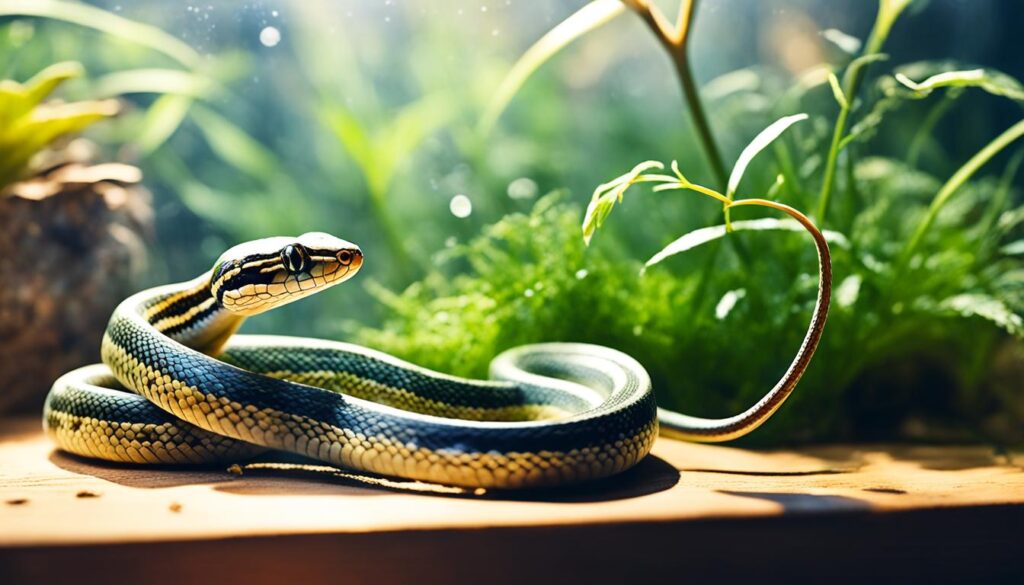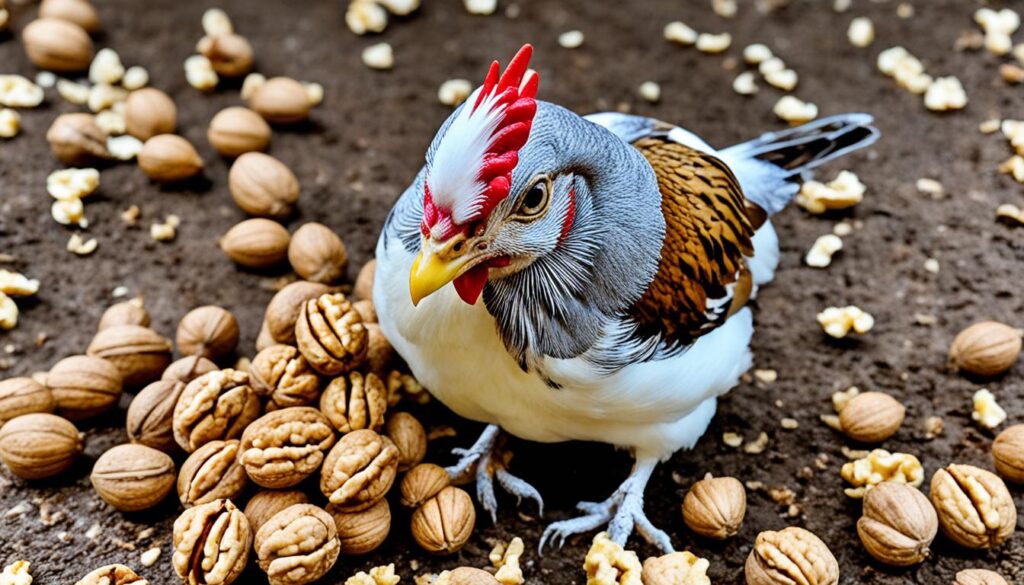Did you know garter snakes can live up to 10 years with the right care? These colorful snakes might seem odd as pets, but they’re great for beginners. They can be interesting pets if you know how to take care of them. We’ll look into what it takes to have a garter snake as a pet. We’ll cover their needs, like their home, food, and behavior, to help you decide if they’re right for you.
Key Takeaways
- Garter snakes can live up to 10+ years with proper care and habitat.
- These snakes typically range from 2 to 4 feet in length as adults.
- Garter snakes require a minimum tank size of 40 gallons for a single adult.
- Proper temperature and humidity levels are crucial for a garter snake’s health.
- Garter snakes need a varied diet of fish, frogs, and small mammals.
Introduction to Garter Snakes as Pets
Garter snakes are small, slender snakes found all over North America. They live partly on land and in water, making them semi-aquatic. These snakes can live in many places, like forests, lawns, and grasslands.
Garter Snake Species Overview
For beginners, garter snakes make great pets. They are small, active during the day, and easy to handle. With the right care, they can be rewarding pets.
Adult garter snakes are 45-120 cm (18-48 inches) long and can live more than 10 years. They live in cooler places in America and Canada. In the wild, they eat amphibians, small fish, or small mammals.
| Garter Snake Characteristic | Details |
|---|---|
| Potential Adult Size | 45-120 cm (18-48 inches) |
| Average Lifespan | 10+ years |
| Habitat | Cooler climates throughout America and Canada |
| Diet in the Wild | Amphibians, small fish, or small mammals |
“Garter snakes can strike if they feel threatened, stressed, or ill, so close supervision is required when handling them, especially around children.”
Caring for a Pet Garter Snake
Housing and Habitat Requirements
Creating the right home is key for a garter snake’s health. They need a big space, at least a 40-gallon tank for one adult snake. The garter snake habitat should have a warm spot around 90°F and a cooler area no lower than 70°F. Keeping the humidity right, between 30-60%, helps their breathing and shedding.
The substrate should be a mix of damp and dry spots. This lets the snake control its temperature and stay hydrated. Add hideouts, branches, and water dishes to meet their needs.
| Habitat Requirement | Ideal Range |
|---|---|
| Enclosure Size | Minimum 40-gallon breeder tank |
| Temperature | Warm basking area: 90°F, Cool zone: 70°F |
| Humidity | 30-60% |
| Substrate | Mix of damp and dry areas |
| Furnishings | Hideouts, branches, water dishes |
“Providing a proper habitat is crucial for the health and well-being of a pet garter snake.”
can you have a garter snake as a pet
Diet and Feeding
Garter snakes eat meat and need a mix of live or frozen-thawed food. They like to eat small fish, amphibians, and small mammals. At home, feed them feeder goldfish, pinkie mice, and other small rodents.
It’s key to give them calcium and garter snake vitamins with their food. Make sure the food fits the snake’s size to prevent health issues. When adding new foods, do it slowly and watch how the snake reacts to avoid stomach problems.
“Garter snakes require a varied diet of live or frozen-thawed prey in captivity, including small fish, amphibians, and small mammals.”

- Garter snakes eat small fish, amphibians, and small mammals in the wild.
- In captivity, they eat feeder goldfish, pinkie mice, and other small rodents.
- They need calcium and vitamin supplements with their food for health.
- Make sure the food is the right size to avoid health problems from overeating.
- Slowly add new foods and watch the snake’s reaction to prevent stomach issues.
Knowing what garter snake food and garter snake feeding they need helps pet owners keep them healthy. Good food and feeding habits are key for these reptiles to live a long and happy life.
Garter snakes are often kept as pets because they are easy to care for and fun to watch.
Garter Snake Behavior and Handling
Garter snakes are usually calm and easy to handle. But, they can strike if they feel scared. It’s key to be calm and quiet around them. Don’t handle them when they are shedding their skin, as they might see your hand as food.
Always watch over kids when they are with a garter snake. The snake might bite if it thinks your hand is food. Make sure to wash your hands before and after touching the snake or its home to keep everyone safe.
Garter Snake Temperament and Safety
Garter snakes are often friendly, but they can be different. Some might be more scared or jumpy than others. Know how to read their body language and don’t surprise or trap them, as this can make them defensive.
- Garter snakes have a tendency to be garter snake behavior and may strike if they feel threatened.
- Proper garter snake handling techniques, such as supporting the snake’s entire body, can help minimize the risk of bites.
- Caution should be exercised when garter snake safety is a concern, especially around children or during the shedding process.
Handling your garter snake with care is key for both you and the snake. By understanding and respecting their nature, you can have a great bond with your pet garter snake.

“Garter snakes are generally docile and manageable pets, but they do require careful handling.”
Conclusion
Keeping a garter snake as a pet can be rewarding for those ready to care for it. These snakes are easy to care for and are friendly, making them great for beginners. But, it’s important to learn about their care needs, like their habitat, diet, and behavior, to give them a good life.
With the right care, a garter snake can be a fun and interesting pet. There are over 30 subspecies to choose from, so you can pick one that fits your home. These snakes are gentle and rarely bite, making them perfect for small spaces.
Before deciding to have a garter snake as a pet, think it over and make sure you can give it the right care. By learning about their needs and making sure you can meet them, you’ll enjoy having a pet garter snake.
FAQ
Can you have a garter snake as a pet?
Yes, garter snakes can be great pets for those new to reptiles. They are lively, easy-going, and come in many colors.
What do garter snakes need for a habitat?
They need a big tank, at least a 40-gallon breeder tank for one snake. The tank should have a warm spot around 90°F and a cooler area at 70°F. Keeping the humidity between 30-60% is also key.
What do garter snakes eat?
These snakes eat live or frozen-thawed prey. Their diet includes small fish, amphibians, and small mammals. At home, they can eat feeder goldfish, pinkie mice, and similar-sized rodents.
How do you handle a garter snake?
Garter snakes are usually friendly but need to be handled with care. They might bite if scared, so move slowly and calmly around them. Always watch kids when they’re with a garter snake.
How long do garter snakes live?
With the right care, garter snakes can live 10-15 years in captivity. Their lifespan depends on the species, health, and how well they are cared for.



